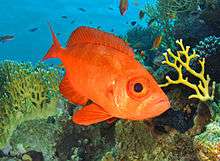Priacanthus blochii
Priacanthus blochii is a marine fish belonging to the family Priacanthidae.[1]
| Priacanthus blochii | |
|---|---|
 | |
| Scientific classification | |
| Kingdom: | Animalia |
| Phylum: | Chordata |
| Class: | Actinopterygii |
| Order: | Perciformes |
| Family: | Priacanthidae |
| Genus: | Priacanthus |
| Species: | P. blochii |
| Binomial name | |
| Priacanthus blochii Bleeker, 1853 | |
Common names
The common names Bloch's bigeye, blotched bigeye, glass-eye, paeony bulleye, paeony bulls-eye or bigeye, big-eye, shortfin bigeye, silver big-eye, and goggle eye are used for this species.
Description
This species has a red body and is commonly 40 cm in length. The lateral line has a line of approximately 15 dark spots. Both the pelvic and median fins are a dusky red colour. At the base of the first 3 pelvic rays, a black spot is present.[2]
Distribution
Priacanthus blochii occurs in the waters of southern Africa to French Polynesia. It is found as far south as Australia and north to the southern waters of Japan. It has also been recorded around Easter Island and as well as in the Red Sea.[2]
Habitat
It is found at depths of 8 to 250 metres in caves or under ledges and inhabits lagoons and seaward reefs.[2]
References
| Wikimedia Commons has media related to Priacanthus blochii. |
- "WoRMS - World Register of Marine Species - Priacanthus blochii Bleeker, 1853". Marinespecies.org. Retrieved 2014-06-30.
- "Priacanthus hamrur, Moontail bullseye : fisheries, aquarium". Fishbase.org. 2012-07-03. Retrieved 2014-06-30.